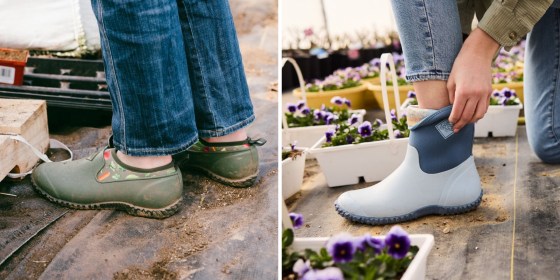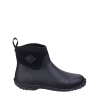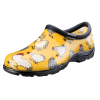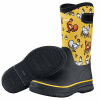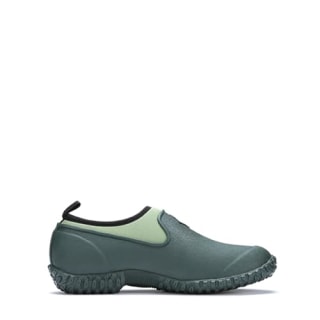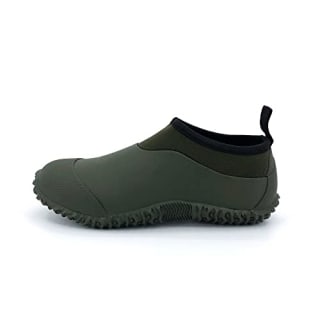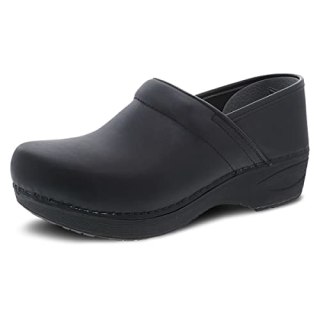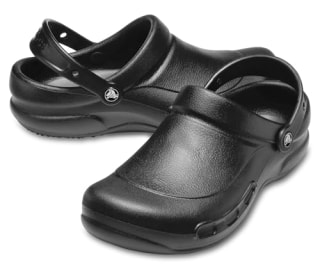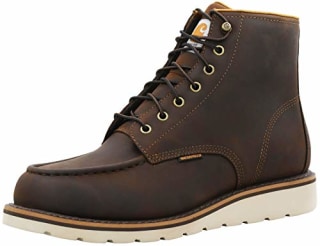Gardening can be one of the most restorative hobbies, but nothing dampens your experience quite like soggy, uncomfortable footwear. Like the best gardening tools, a great pair of gardening shoes is a worthy investment, according to our experts. Some benefits, such as comfort and support, are similar to a street or running shoe, but gardening shoes also offer “protection from the elements, such as soil, weeds, mulch, critters [and moisture],” says Eric Preston Stout, expert gardener and landscaper with TeachMe.To.
That said, since certain styles and materials are better suited for certain jobs, you’ll want to do some preliminary research prior to purchasing. To find the best gardening shoes, we spoke to a professional landscaper, a farmer and two gardeners. Below, we share their favorite brands as well as qualities to consider before choosing a pair.
SKIP AHEAD How we picked the best gardening shoes | The best garden shoes in 2024 | How to shop for gardening shoes | Why trust Select?
How we picked the best gardening shoes
The best gardening shoes are protective, easy to slip on, comfortable to wear and durable enough to withstand the elements, according to our experts. We considered the following factors while building this list:
- Shoe type: Gardening shoes come in various styles, including clogs, closed shoes and boots of various heights. Whichever you choose, the pair should have a closed toe, a slip-on design and a flexible ankle, according to our experts.
- Comfortability: Since you’ll be on your feet for extended periods of time, the ideal gardening shoe will have a supportive footbed and a spacious fit, according to our experts.
- Durability: The best gardening shoes are made from thick, durable materials like leather and rubber, says Stout. While you can get away with a water-resistant shoe for light gardening, most of our experts prefer a fully waterproof shoe that’s easy to clean and keeps your feet dry.
The best garden shoes in 2024
In addition to our experts’ recommendations, we also included bestselling gardening shoes that have at least a 4.3-star rating from over 6,000 reviews on Amazon.
Muck Muckster Men’s II Ankle Boot
- Durable
- Waterproof
- High, flexible collar
- Pricey
Three of our experts recommend these men’s Muck boots for gardening because of their quality and durability. “They are comfortable, spacious, waterproof and can last a long time,” says Sarah Akovic, a regenerative farmer and greenhouse manager at Case Western Reserve University. These Muckster ankle boots are 100% waterproof due to their rubber outsole and neoprene lining, according to the brand. Per our experts’ advice, they also have a high collar to keep dirt out, a flexible ankle to allow for comfortable crouching and a pull tab to help you slip them on more easily. (You can shop for women’s versions of the shoes here).
Shoe type: boot | Materials: rubber, neoprene | Available sizes: 7-15 (men’s sizes) | Color options: 3
Muck Muckster 2 Women’s Low Slip-On
- Waterproof
- Supportive insole
- Easy to slip on
- Pricey
Muck makes slip-on shoes as well as boots, and they’re just as durable and supportive, says Madeline Hooper, gardener and creator/host of the television show “GardenFit”. This pair has a fully waterproof exterior, a sweat-wicking lining, a shock-absorbing insole and a high-traction outsole, according to Muck. They’re also designed for slip-on convenience — they have a low, flexible collar and built-in pull tab.
Shoe type: closed shoe | Materials: rubber, neoprene | Available sizes: 5-11 (women’s sizes) | Color options: 2
Sylphid Unisex Waterproof Garden Shoes
- Affordable
- Unisex sizing
- Waterproof
- Not as durable
If you’re looking for a more affordable alternative to Muck, these garden shoes have a similar design, including a rubber exterior, textured outsole and flexible collar. Despite their lower price tag, they’ve earned an average 4.3-star rating from over 6,000 reviews on Amazon. Since they’re made from a combination of rubber and neoprene, they’re waterproof on the outside and sweat-wicking on the inside, according to the brand. They also have a pull-tab so you can slip them on.
Shoe type: closed shoe | Materials: rubber, neoprene | Available sizes: 5.5/4.5 -15/13 (unisex sizes) | Color options: 8
Sloggers Women’s Waterproof Garden Shoe
- Waterproof
- Arch-support insoles
- Colorful patterns
- Materials undisclosed
These Sloggers garden shoes are a number one bestseller on Amazon, with an average 4.6-star rating from over 17,000 reviews. While the exact material of these shoes are undisclosed, they’re made with a medical-grade, latex-free upper that has the consistency of rubber, so it’s waterproof and easy to clean, according to the brand. They also have a slip-on design with a textured outsole and an arch-supporting insole, plus they come in tons of colorful patterns.
Shoe type: closed shoe | Materials: N/A | Available sizes: 6-11 (women’s sizes) | Color options: 27
Dansko XP Women’s 2.0 Clogs
- Nonslip
- Waterproof leather
- Cushioned footbed
- Pricey
Stout recommends Dansko clogs due to their comfortability and convenient slip-on design. Originally made for barn work but now popular among nurses and servers, these shoes are lightweight with a thick, slip-resistant outsole and a memory foam cushioned insole that’s removable, according to the brand. Per Stout’s suggestion, they’re made from leather, but this particular pair is waterproof to keep out dirt and moisture.
Shoe type: closed shoe | Materials: leather, memory foam | Available sizes: 4.5/5 -12.5/13 wide (women’s sizes) | Color options: 41
Crocs Bistro Clogs
- Contoured footbed
- Ankle strap
- Easy to clean
- Won’t keep out dirt
Because they’re made from a waterproof material with contoured footbeds and a slip-on design, Crocs meet our experts’ criteria for a reliable gardening shoe. This Bistro pair has a 4.5-star rating from over 66,000 reviews. The style has fewer holes than the brand’s original clog to keep out more dirt and moisture, though they still have cut-outs on the sides for ventilation. While they slip on easily, they also have a heel strap for a more secure fit, plus they’re easy to rinse clean, according to the brand. (For Crocs with no holes and a higher back, opt for the On the Clock clog.)
Shoe type: clog | Materials: thermoplastic elastomers | Available sizes: 6/4 - 17/15 (unisex sizing) | Color options: 3
Hisea Women’s Barn Boots
- High but flexible
- Lifetime warranty
- Plush, dry interior
- Too warm for hot weather
For cold or muddy gardening, Christy Wilhelmi (gardener and owner of the blog Gardenerd) uses and recommends these barn boots, which have a lifetime guarantee and “are very comfortable.” The bottom of the boot is made from sealed rubber and the cuff reaches to the mid-calf to keep out dirt and water, but the top is made from flexible neoprene to prevent restriction. These boots also have an anti-slip outsole, a plush footbed for warmth and a built-in handle to help you pull them on, according to the brand.
Shoe type: boot | Materials: rubber and neoprene | Available sizes: 5-11 (women’s sizes) | Color options: 5
Carhartt Men’s Waterproof Wedge Soft Toe Boot
- Protective
- Waterproof
- Foam insole
- Not slip-on
“If moving heavy materials or digging, a boot is a better option,” says Stout, who recommends Carhartt boots because they’re rugged, water-resistant and supportive. This pair has a soft toe with a breathable leather membrane, but they’re still waterproof and protective when landscaping, according to the brand. They also have a foam insole to cushion your feet and a thick, textured outsole for traction. This pair has a 4.5-star rating from over 8,000 reviews.
Shoe type: boot | Materials: leather, rubber, foam | Available sizes: 7-15 Wide (men’s sizes) | Color options: 5
How to shop for gardening shoes
The best gardening shoe for you will depend on the weather and the task at hand. The higher the ankle, the less moisture and debris you’ll get in your shoe, though higher ankles often feel more restrictive, according to our experts.
Types of gardening shoes
Like everyday shoes, gardening shoes come in a variety of designs, including clogs, closed shoes and boots. Each type has its benefits and drawbacks, so it’s largely a matter of personal preference — but gardening shoes should always have a closed toe to protect your feet from tools and equipment, says Stout.
- Clogs: Clogs have a rounded, closed toe and a backless design, which makes them the easiest shoe to slip on without having to fiddle with cuffs or clasps, according to our experts. However, they’re best for gentle gardening or those who don’t mind dirty socks, as their low back won’t prevent mud or water from entering the shoe.
- Closed shoes: Like sneakers, closed gardening shoes have an ankle-height collar that goes all the way around, which keeps dirt out, but still allows you to bend your ankle. As a result, they’re the most recommended style among our experts.
- Boots: Due to their taller, more structured design, boots (sometimes called wellies) are the best option if you’re digging, using heavy equipment, working in cold or wet environments or gardening in tall grass where you might find ticks, according to our experts. That said, when opting for a higher boot, the material around the ankle should be flexible, since gardening requires a lot of crouching and bent ankles are the key to balance, says Hooper.
Other factors to consider when shopping for gardening shoes
Once you’ve chosen a style, our experts recommend that you consider the following criteria to help you narrow down a specific pair:
- Slip-on design: No matter which style of gardening shoe you choose, a slip-on design is extremely convenient: “I am going in and out of the house often during my gardening day and they save lacing up time,” says Hooper. If you opt for a boot, the pair should have a loop or a handle you can use to pull them on, says Wilhelmi.
- Materials: Leather or rubber are the ideal materials for gardening shoes because they’re water-resistant, durable and easy to clean, says Stout.
- Support: Granted gardening requires plenty of movement and may put pressure on your joints, shoes with proper support are paramount, according to our experts. However, the ideal type of support differs from person to person: Akovic prefers shoes with plenty of cushioning in the sole, which removes pressure from the knees. Wilhelmi likes gardening shoes with built-in arch support, but you can also opt for a pair that lets you add your own inserts.
- Price: “If there is one article of gardening apparel to splurge on, it is shoes,” says Hooper. Comfort, durability and protection are worth the price tag — but you can find a great pair for under $100, and they’ll ideally come with a warranty, according to our experts.
- Size/fit: Our experts recommend choosing a gardening shoe with a spacious fit, so your feet won’t feel cramped or restricted. Hooper recommends sizing up if needed to ensure enough room for socks.
Should gardening shoes be waterproof?
Some gardening shoes are water-resistant while others are fully waterproof. If you don’t plan on gardening in the rain, water-resistant shoes should suffice, says Stout. That said, the rest of our experts prefer fully waterproof shoes because they don’t absorb dirt and moisture and they keep your feet dry despite water from the hose and dew from the grass.
Do you wear socks with gardening shoes?
While wearing socks is usually a personal choice, they’re recommended alongside gardening shoes: “Socks not only protect your feet from cold or heat [but] they can prevent bug bites,” says Hooper. They also absorb moisture to prevent blisters and chafing.
Meet our experts
At NBC Select, we work with experts who have specialized knowledge and authority based on relevant training and/or experience. We also take steps to ensure all expert advice and recommendations are made independently and without undisclosed financial conflicts of interest.
- Eric Preston Stout is an expert gardener and landscaper with TeachMe.To.
- Sarah Akovic is a regenerative farmer and greenhouse manager at Case Western Reserve University.
- Madeline Hooper is a gardener and the creator/host of the television show GardenFit.
- Christy Wilhelmi is a gardener and the owner of the blog Gardenerd.
Why trust NBC Select?
Maria Cassano is a writer, editor and consultant who specializes in e-commerce. You can find her home and outdoor articles in publications such as Bustle, Elite Daily, CNN, Food & Wine, Lonny and Better Homes & Gardens. For this article, she interviewed a farmer, a landscaper and two gardeners.
Catch up on Select’s in-depth coverage of personal finance, tech and tools, wellness and more, and follow us on Facebook, Instagram, Twitter and TikTok to stay up to date.
